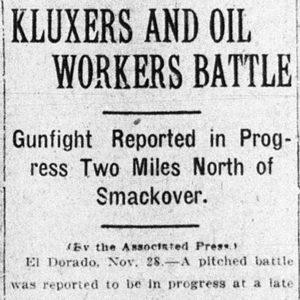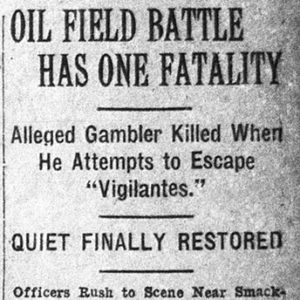calsfoundation@cals.org
Smackover Riot of 1922
In late November 1922, a hooded and robed “cleanup committee”—possibly members of the Ku Klux Klan (KKK) or some related group—rode through the Smackover (Union County) oil fields in order to drive away “undesirable” people, such as saloon owners and gamblers. The vigilantes killed at least one person, shot at others, and destroyed buildings, and there were widespread reports of floggings and even cases of people being tarred and feathered. This multi-day riot mirrored other vigilante actions in the newly established oil fields in Arkansas. The previous February, the citizens of El Dorado (Union County) had formed a “Law Enforcement League” for the same purpose.
Smackover is located twelve miles north of El Dorado in Union County, an area that had relied on cotton, and later the timber industry, for its livelihood. On July 1, 1922, sawmill owner Sidney Albert Umsted struck oil, and the economy was transformed. Within six months, more than 1,000 wells had been drilled, and the population of Smackover soared from ninety to 25,000. The town was incorporated on November 3, 1922. Along with all the oil workers came the “disreputable” element common to all boom towns: saloonkeepers, gamblers, and prostitutes. The town was so lawless that none of the twenty-five people who petitioned for incorporation were willing to hold office.
There are various reports on just how the trouble started. The New York Times reported on November 30 that the murder of oil worker Ed Cox on November 24 precipitated the events. According to the Arkansas Gazette, the next night’s murder of driller “Cotton” Parsons outside of a “dive” in Patagonia (another oil field settlement), was the cause. The Bismarck Tribune reported that the battle started when a man was tarred and feathered. An Associated Press report, published in the Niagara Falls Gazette on November 29, traced the trouble to the killing of an oil worker near Smackover on November 26. Whatever the case, a cleanup committee was formed to deal with the increase in lawlessness in the area. On November 27, more than 200 masked and robed men drove through Smackover in cars, carrying signs that warned “gamblers and others of the lawless element” to leave the area within twenty-four hours.
According to the Niagara Falls Gazette, on the night of November 28, members of the committee, accompanied by some oil field workers and local residents, visited the “resort” where the murder occurred, ordered those in the building to leave, and then burned the building. The citizens’ group then visited other objectionable establishments and warned the proprietors to leave or suffer the consequences. Reportedly a number of “undesirables” were whipped by the posse. Both the Arkansas Gazette and the Niagara Falls Gazette describe a subsequent battle between a group of about 200 members of the vigilance committee and twenty-five oil field workers. This supposed “pitched battle” occurred two miles north of Smackover during the night and early morning of November 28 and 29. While many shots were fired, there was scant information about the incident and the number of fatalities could not be determined. The Niagara Falls paper, however, did assert that there were a number of men wounded, several of whom were near death.
Other newspapers published more sensational reports. On November 29, the Seattle Star reported that “two thousand bootleggers, dive keepers and gamblers are aligned against the vigilantes in the skirmish, which first flared last night and raged for hours.” Unconfirmed reports indicated that sixty-five people had been killed or wounded. The vigilantes were reportedly wearing the robes of the Ku Klux Klan. On November 30, the New York Times reported that one man had been killed, four injured, and five tarred and feathered. They identified the dead man as “Slim” Sanders, who was the proprietor of one of the undesirable establishments. According to the Washington Times, early reports indicated that the battle between a mob of 200 “white-robed and masked men” and a group of oil workers and reputed gamblers was “one of the most spectacular engagements ever noted in this section.” They did note, however, that later reports indicated that no one had been killed, and that the vigilantes were Smackover residents and not members of the KKK. Although the Klan was beginning to threaten bootleggers and gamblers in Arkansas during this period, KKK officials at Camden (Ouachita County) supported the claim that the KKK was not involved.
On November 30, the Arkansas Gazette reported that there had been only one fatality, that of E. J. Wood (referred to as J. G. Woods in some reports and also known as “John Few Clothes” and “Fenrose”), who was killed on Tuesday night at an oil field known as Ouachita City. Unmasked members of the vigilance committee approached what they believed to be a gambling house, supposedly owned by Wood and Slim Sanders. Upon their arrival, Wood ran out the door. Committee members told him to halt, and he was shot when he refused. Wood was initially reported tarred and feathered, but this was later proven false. The house itself was burned down by the committee. According to recently elected sheriff J. B. Newton, however, all reports of a pitched battle, tarring and feathering, and burned buildings were highly exaggerated; most of the gunshots had been fired into the air, and Sanders’s building had been torn down, but none had been burned. The New York Times reported that, among the supposed 2,000 vigilantes, 400 were on the payroll of the oil companies. The size of the vigilante group was estimated to be much smaller, approximately 200 people, by most other sources.
Following these events, large numbers of “undesirables” began to flee the area. By November 30, approximately 1,100 had departed by train from nearby Camden. Although there were rumors that they were gathering in Union County and El Dorado to seek their revenge, Ouachita County authorities assured residents that there would be no more trouble. On December 1, the Arkansas Gazette reported that Sheriff Ed Harper had returned to Camden after touring the oil fields. He found no sign of further trouble and reported that “the undesirable element seems to have been thoroughly cleaned out.” Smackover constable Hampton Lewis and local bank cashier O. B. Gordon “deplored the publicity given the raids…merely a repetition of events which had occurred in all new oil fields.” No one was ever arrested for the murder of E. J. Wood. The coroner’s jury met and found that he had died at the hands of persons unknown.
On December 5, 1922, the Arkansas Gazette reported that unknown persons had posted notices through the oil fields of southern Ouachita County reading, “Nigger, read and leave,” thus prompting an exodus of African Americans from the area. However, Sheriff Harper insisted that members of the vigilance committee were not responsible for the deed.
For additional information:
“200 White Robed Men Fight with Gamblers.” Washington Times, November 29, 1922, p. 1.
“2000 Flee from Raiders: Arkansas ‘Undesirables’ Threaten to Return for Revenge.” New York Times, December 1, 1922, p. 6.
“Begin Efforts to Clean Smackover.” Arkansas Gazette, November 28, 1922, p. 1.
“Citizens Launch Drive to Clean up Smackover Field.” Arkansas Gazette, November 28, 1922, p. 3.
“Kluxers and Oil Workers Battle.” Arkansas Gazette, November 29, 1922, p. 1.
“Many Wounded When Oil Field Men Fight Vigilantes, Report.” Niagara Falls Gazette, November 29, 1922, p. 1.
“Masked Vigilantes Kill 1 in Arkansas.” New York Times, November 30, 1922, p. 14.
“More than 1,000 Leave Oil Field.” Arkansas Gazette, December 1, 1922, p. 1.
“Negroes Quit the Ouachita Oil Field.” Arkansas Gazette, December 5, 1922, p. 1.
“Oil Field Battle Has One Fatality.” Arkansas Gazette, November 30, 1922, p. 1.
“Oil Field ‘Clean-Up’ Seems to Have Ended.” Arkansas Democrat, November 30, 1922, p. 1.
“Report 65 Slain in Oil Fields.” Seattle Star, November 29, 1922, p. 1.
“Undesirable Refugees Flock out of Ouachita Oil Fields.” Arkansas Democrat, December 1, 1922, p. 2.
“Vigilantes, Oil Men in Hard Battle.” Bismarck Tribune (North Dakota), December 1, 1922, p. 2.
“Vigilantes Open Vice War in Ouachita Oil Fields.” Arkansas Democrat, November 29, 1922, p. 1.
Nancy Snell Griffith
Clinton, South Carolina
 Early Twentieth Century, 1901 through 1940
Early Twentieth Century, 1901 through 1940 Law
Law Prohibition
Prohibition Smackover Riot Article
Smackover Riot Article  Smackover Riot Article
Smackover Riot Article 




Just a note here: There are at least a couple of photographs on the Internet showing a mass gathering on the streets of Smackover during this riot period. One of them is dated Dec. 1, the other simply dated Sunday. The pictures were taken by SC Wilson. These photos certainly add to the description of what happened during those early boom town days. (I grew up in the Quinn, Arkansas, community about ten miles from Smackover.) (Editor’s note: We do not have permission to use these photos on our site.)